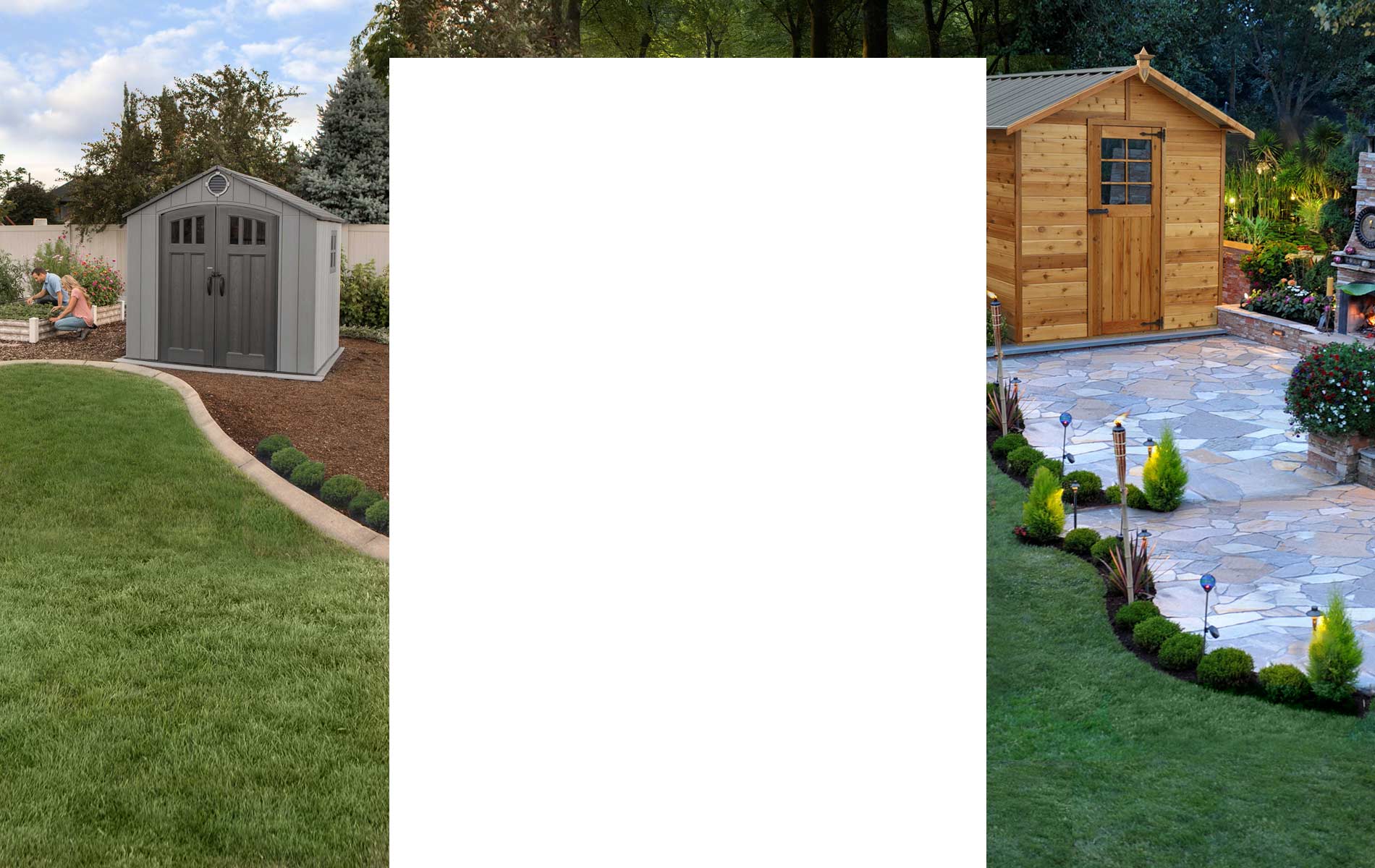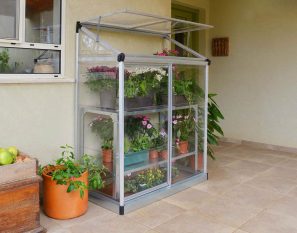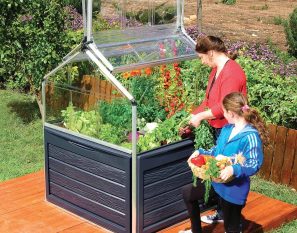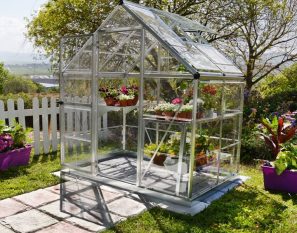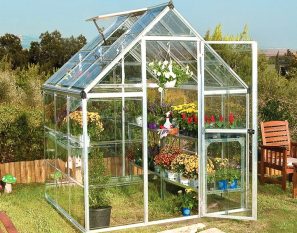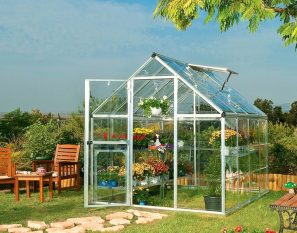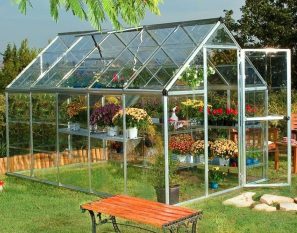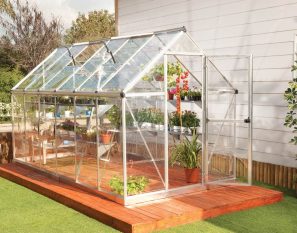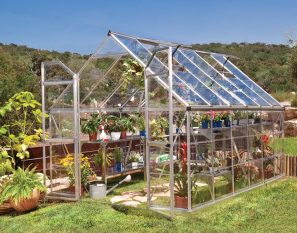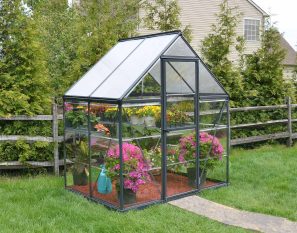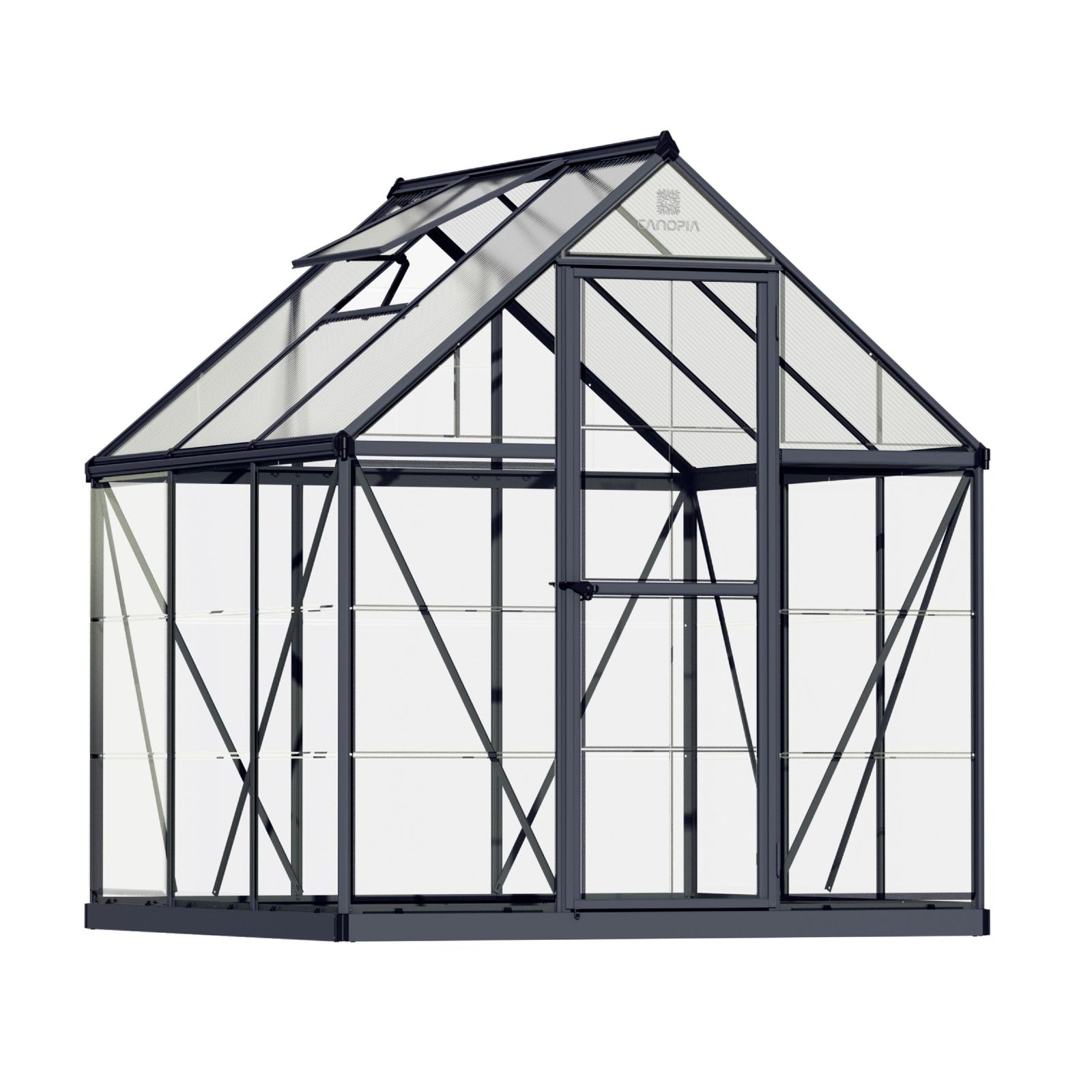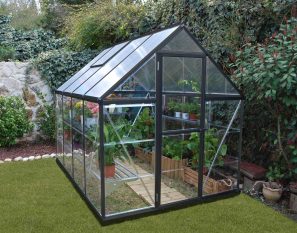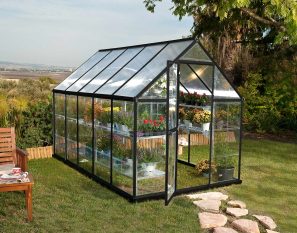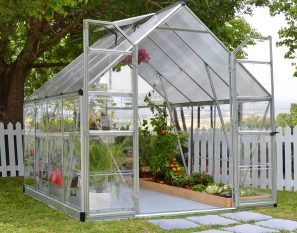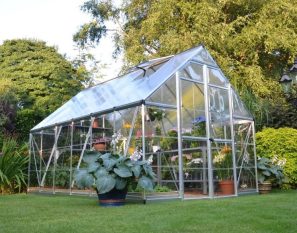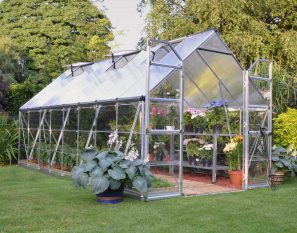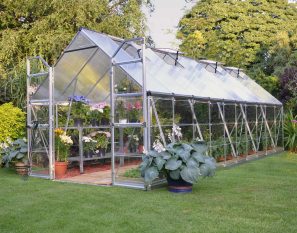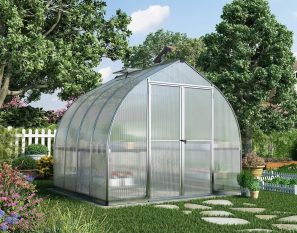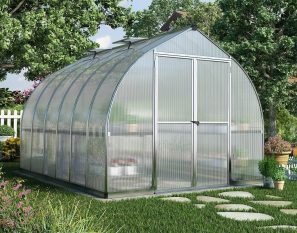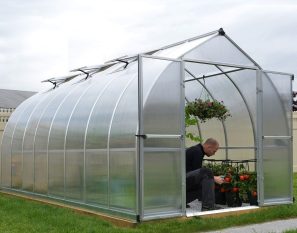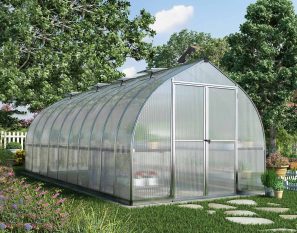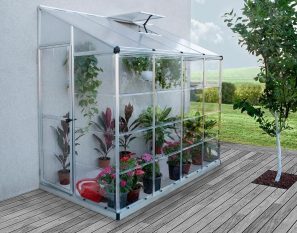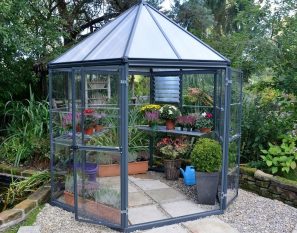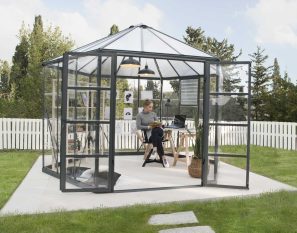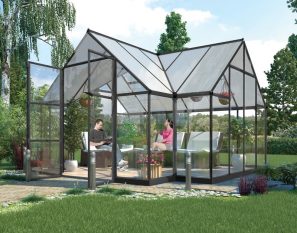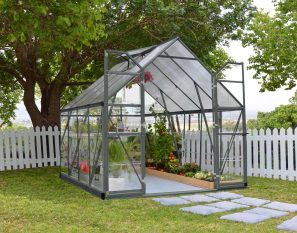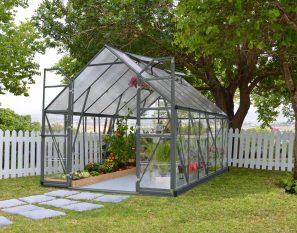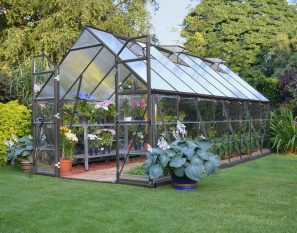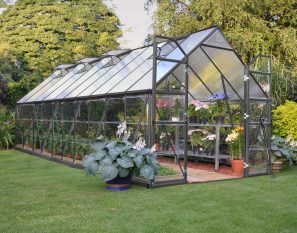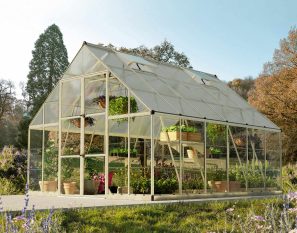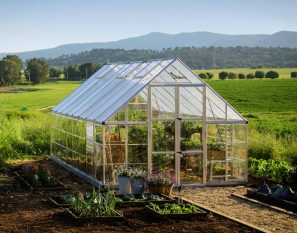Warning: Trying to access array offset on value of type null in /home/lander/public_html/wp-content/themes/woodstock/woocommerce/archive-product.php on line 94
GREENHOUSES - POLYCARBONATE
Greenhouses are something everyone who is interested in gardening would like to have. Being able to propagate plants in controlled conditions, to grow your own vegetables and flowers without having to contend with birds, animals and pests – is something that all greenthumbs would like. Many people are interested in how to build a greenhouse – and the kitform plastic greenhouses such as the SILVER LINE units are an easy, neat and economical solution.
SILVERLINE polycarbonate plastic greenhouses by Palram range in size from the SINGLE COLD FRAME right through a range of mini greenhouses to the AMERICANA 12 x 12 GREENHOUSE, and cater for every situation, including small courtyards, patios and balcony gardens. The robust aluminium extrusion greenhouse frame and the virtually unbreakable polycarbonate plastic glazing are designed for long, trouble-free lifespan. High quality, ease of assembly and very competitive pricing are the benefits that make them one of the most popular ranges of polycarbonate greenhouses on the Australian market.
See why polycarbonate is widely used instead of glass in greenhouses these days.
Like to know more about plastic greenhouse/hot house products and their use? Go to Landera Blog and search 'greenhouse' for more information and related articles. Or you can find a great range of books relating to the setting up and operation of your greenhouse by searching 'greenhouse gardening' at online stores such as Book Depository.
Greenhouses are becoming more widely used, not only because many people prefer to grow their own vegetables and flowers, but also they are finding gardening a great way to unwind. Large garden spaces are often not available and greenhouses are proving an excellent way of increasing crop yields in small areas.
The SILVER LINE polycarbonate plastic greenhouse units from PALRAM are widely distributed globally and enjoy an excellent reputation of value for money. The robust aluminium extrusion frame system and the virtually unbreakable polycarbonate plastic glazing make a great product!
Interesting Facts about Greenhouses
Greenhouses have been in use for at least 2000 years. The earliest examples of course were not anything like the polycarbonate plastic greenhouses available today, but the basic concept was the same. They need to provide an environment which protects plants from the extremes of cold and heat, winds and the damage caused by various pests. Greenhouses are also used to extend a plant's growing season and even to enable a gardener to grow non-native plants which would not survive in the open.
One of the first known examples of a greenhouse was the specularium constructed for the Roman emperor Tiberius who was advised by his physicians to eat a cucumber every day. This greenhouse apparently featured stone walls and a translucent roof which was made from small pieces of mica to let in the sunlight. Heating was provided by fires burning against the outside of the stone walls.
The modern greenhouse concept was developed in the 1500s by botanists and collectors interested in propagating exotic species of plants discovered by explorers. An early greenhouse with glass roof and walls was built in Holland by the French botanist Jules Charles who wanted to grow tropical plants. (The Netherlands has certainly maintained and expanded this tradition – huge areas of land are covered by greenhouses and hothouse vegetables and flowers are grown in enormous quantities; if you look at The Hague, Netherlands on googlemaps.com you will see that almost half the city is made up of commercial greenhouses. Visitors to The Hague notice the glow in the night sky of lights which are left on to assist plant growth).
During the 1600s glasshouses became fashionable with the aristocracy in Europe, and increasingly elaborate and expensive examples where built in various places. The orangerie at the Palace of Versailles constructed during the reign of Louis XIII was over 150 metres long, 12 metres wide and nearly 14 metres high. Of course, the immense cost of such a project was of no consequence to the king, but as glass was very expensive in those times greenhouses were strictly a luxury item for the very wealthy.
By the mid 1800s glass was being produced in large quantities and the cost was greatly reduced. Glasshouses became more common and some amazing examples were built. One which still stands is the Palm House in the Kew Gardens. This took 4 years to build and was completed in 1848. It featured an iron framework with open spaces free from pillars and utilised design concepts based on shipbuilding, which was also undergoing the radical change from wooden construction to iron.
Since then design and construction has evolved, and these days greenhouses are readily available in a wide range of types, sizes and price ranges. The frame construction, traditionally using timber, has moved through steel to extruded aluminium sections. Nowadays, glass is often replaced with plastics such as polycarbonate which has excellent light transmission qualities and is virtually unbreakable.
We make it even easier for you – at Landera we offer FREE DELIVERY to your address in Australia on all greenhouse products shown below!
-
SILVERLINE MAZE LEAN-TO MINI GREENHOUSE
$545.00- [yith_wcwl_add_to_wishlist]
- [yith_compare_button]
SILVERLINE PLANT-INN MINI GREENHOUSE 1.2mx1.2m
$850.00- [yith_wcwl_add_to_wishlist]
- [yith_compare_button]
SILVERLINE 6’x4′ GREENHOUSE 1.8mx1.3m
$999.00- [yith_wcwl_add_to_wishlist]
- [yith_compare_button]
SILVERLINE 6’x6′ GREENHOUSE 1.8mx1.8m
$1,175.00- [yith_wcwl_add_to_wishlist]
- [yith_compare_button]
SILVERLINE 6’x8′ GREENHOUSE 1.8mx2.4m
$1,290.00- [yith_wcwl_add_to_wishlist]
- [yith_compare_button]
SILVERLINE 6’x10′ GREENHOUSE 1.8mx3.1m
$1,499.00- [yith_wcwl_add_to_wishlist]
- [yith_compare_button]
SILVERLINE 6’x12′ GREENHOUSE 1.8mx3.7m
$1,729.00- [yith_wcwl_add_to_wishlist]
- [yith_compare_button]
SILVERLINE 8’x12′ GREENHOUSE 2.4mx3.6m
$1,789.00- [yith_wcwl_add_to_wishlist]
- [yith_compare_button]
HYBRID 6’x4′ GREY GREENHOUSE
$1,050.00- [yith_wcwl_add_to_wishlist]
- [yith_compare_button]
6′ x 6′ Hybrid Greenhouse – Grey Frame
$1,250.00- [yith_wcwl_add_to_wishlist]
- [yith_compare_button]
HYBRID 6’x8′ GREY GREENHOUSE
Pre-order, arriving in May 2025$1,350.00- [yith_wcwl_add_to_wishlist]
- [yith_compare_button]
HYBRID 6’x10′ GREY GREENHOUSE
$1,699.00- [yith_wcwl_add_to_wishlist]
- [yith_compare_button]
BALANCE 8’X8′ GREENHOUSE 2.4mx2.4m SILVER
$1,930.00- [yith_wcwl_add_to_wishlist]
- [yith_compare_button]
BALANCE 8’X12′ GREENHOUSE 2.4mx3.6m SILVER
$2,570.00- [yith_wcwl_add_to_wishlist]
- [yith_compare_button]
BALANCE 8’X16′ GREENHOUSE 2.4mx4.8m SILVER
$3,240.00- [yith_wcwl_add_to_wishlist]
- [yith_compare_button]
BALANCE 8’X20′ GREENHOUSE 2.4mx6m SILVER
$3,880.00- [yith_wcwl_add_to_wishlist]
- [yith_compare_button]
BELLA 8’x8′ GREENHOUSE 2.4mx2.4m
$2,340.00- [yith_wcwl_add_to_wishlist]
- [yith_compare_button]
BELLA 8’x12′ GREENHOUSE 2.4mx3.5m
$3,210.00- [yith_wcwl_add_to_wishlist]
- [yith_compare_button]
BELLA 8’x16′ GREENHOUSE 2.4mx4.8m
$4,080.00- [yith_wcwl_add_to_wishlist]
- [yith_compare_button]
BELLA 8’x20′ GREENHOUSE 2.4mx5.9m
$4,850.00- [yith_wcwl_add_to_wishlist]
- [yith_compare_button]
SILVERLINE LEAN-TO GREENHOUSE / SUNROOM 1.2mx2.4m
$1,320.00- [yith_wcwl_add_to_wishlist]
- [yith_compare_button]
OASIS HEXAGONAL GREENHOUSE 2.5m
$2,680.00- [yith_wcwl_add_to_wishlist]
- [yith_compare_button]
OASIS HEXAGONAL GREENHOUSE 3.6m
Pre-order arriving in June 2025$4,890.00- [yith_wcwl_add_to_wishlist]
- [yith_compare_button]
SILVER LINE VICTORY GARDEN CHALET
$4,450.00- [yith_wcwl_add_to_wishlist]
- [yith_compare_button]
BALANCE 8’X8′ GREENHOUSE 2.4mx2.4m GREY
Pre-order - stock arrives May 2025$2,260.00- [yith_wcwl_add_to_wishlist]
- [yith_compare_button]
BALANCE 8’X12′ GREENHOUSE 2.4mx3.6m GREY
Pre-order - stock arrives May 2025$2,890.00- [yith_wcwl_add_to_wishlist]
- [yith_compare_button]
BALANCE 8’X16′ GREENHOUSE 2.4mx4.8m GREY
Pre-order - stock arrives May 2025$3,660.00- [yith_wcwl_add_to_wishlist]
- [yith_compare_button]
BALANCE 8’X20′ GREENHOUSE 2.4mx6m GREY
Pre-order - stock arrives May 2025$4,380.00- [yith_wcwl_add_to_wishlist]
- [yith_compare_button]
BALANCE 10’X12′ GREENHOUSE 3mx3.6m
$3,100.00- [yith_wcwl_add_to_wishlist]
- [yith_compare_button]
BALANCE 10’X16′ GREENHOUSE 3mx4.8m
$3,950.00- [yith_wcwl_add_to_wishlist]
- [yith_compare_button]
